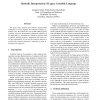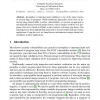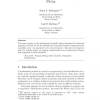681 search results - page 41 / 137 » Superblock formation using static program analysis |
WCRE
2005
IEEE
14 years 2 months ago
2005
IEEE
We apply static analysis and symbolic interpretation techniques to reverse engineer the semantics of legacy assembler code. We examine the case of IBM-1800 programs in detail. Fro...
VL
1991
IEEE
14 years 17 days ago
1991
IEEE
The Conceptual Programming environment, CP, being developed at the Computing Research Laboratory (CRL), is a complete knowledge representation visual programming environment for u...
DIMVA
2006
13 years 10 months ago
2006
Incomplete or improper input validation is one of the major sources of security bugs in programs. While traditional approaches often focus on detecting string related buffer overfl...
ENTCS
2006
13 years 9 months ago
2006
This paper reports on the development of specific slicing techniques for functional programs and their use for the identification of possible coherent components from monolithic c...
CJ
2010
13 years 6 months ago
2010
Abstract. Semantics-based program analysis uses an abstract semantics of programs/systems to statically determine run-time properties. Classic examples from compiler technology inc...



